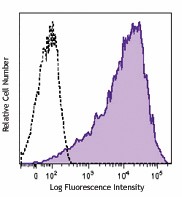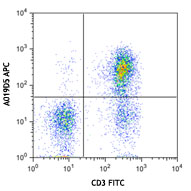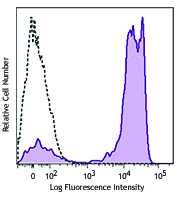- Clone
- M-A251 (See other available formats)
- Regulatory Status
- RUO
- Workshop
- IV A053
- Other Names
- IL-2 receptor α chain, Low affinity IL-2R, IL-2Rα chain
- Isotype
- Mouse IgG1, κ
- Ave. Rating
- Submit a Review
- Product Citations
- publications

-

PHA-stimulated (3 day) human peripheral blood lymphocytes were stained with CD25 (clone M-A251) PE (filled histogram) or mouse IgG1, κ PE isotype control (open histogram).
CD25 is a 55 kD type I transmembrane glycoprotein also known as low affinity IL-2 receptor α chain or Tac. It is expressed on progenitor lymphocytes, activated T and B cells, and activated monocytes/macrophages. CD25 is also expressed on a subset of non-stimulated CD4+ T cells termed T regulatory cells. Soluble CD25/IL-2Rα is produced as a consequence of lymphocyte stimulation and is found in biological fluids following inflammatory responses. CD25 associates with IL-2 receptor β (CD122) and common γ (CD132) chains to form a high affinity IL-2R complex.
Product DetailsProduct Details
- Reactivity
- Human
- Antibody Type
- Monoclonal
- Host Species
- Mouse
- Immunogen
- Human PHA-induced lymphocyte cells
- Formulation
-
µg size: Phosphate-buffered solution, pH 7.2, containing 0.09% sodium azide.
test sizes: Phosphate-buffered solution, pH 7.2, containing 0.09% sodium azide and BSA (origin USA). - Preparation
- The antibody was purified by affinity chromatography and conjugated with PE under optimal conditions.
- Concentration
- µg sizes: 0.2 mg/mLtest sizes: lot-specific (to obtain lot-specific concentration and expiration, please enter the lot number in our Certificate of Analysis online tool.)
- Storage & Handling
- The antibody solution should be stored undiluted between 2°C and 8°C, and protected from prolonged exposure to light. Do not freeze.
- Application
-
FC - Quality tested
- Recommended Usage
-
Each lot of this antibody is quality control tested by immunofluorescent staining with flow cytometric analysis. For flow cytometric staining using the µg size, the suggested use of this reagent is ≤0.4 µg per million cells in 100 µl volume. For flow cytometric staining using tests sizes, the suggested use of this reagent is 5 µl per million cells in 100 µl staining volume or 5 µl per 100 µl of whole blood.
- Excitation Laser
-
Blue Laser (488 nm)
Green Laser (532 nm)/Yellow-Green Laser (561 nm)
- Application Notes
-
Additional reported applications (for the relevant formats) include: immunohistochemical staining of paraformaldehyde fixed frozen sections1 and spatial biology (IBEX)2,3.
The CD25 molecule reveals three epitope regions: A, B, and C. M-A251 antibody recognizes epitope region B. Unlike other CD25 antibody clones, M-A251 can detect CD25 after fixation with paraformaldehyde. -
Application References
(PubMed link indicates BioLegend citation) - Product Citations
- RRID
-
AB_2561860 (BioLegend Cat. No. 356103)
AB_2561861 (BioLegend Cat. No. 356104)
AB_2564145 (BioLegend Cat. No. 356134)
Antigen Details
- Structure
- Type I transmembrane glycoprotein, 55 kD; low-affinity IL-2 receptor α chain
- Distribution
-
Activated T and B cells, monocytes/macrophages, Tregs
- Interaction
- Associates with IL-2Rβ/CD122 and IL-2Rγ/CD132 receptor chains to form a high-affinity IL-2R complex
- Ligand/Receptor
- IL-2
- Cell Type
- B cells, Macrophages, Monocytes, T cells, Tregs
- Biology Area
- Cell Biology, Immunology, Neuroscience, Neuroscience Cell Markers
- Molecular Family
- CD Molecules, Cytokine/Chemokine Receptors
- Antigen References
-
1. Knapp W, et al. 1989. Leucocyte Typing IV: White Cell Differentiation Antigens. Oxford University Press.
2. Schlossman S, et al. 1995. Leucocyte Typing V: White Cell Differentiation Antigens. Oxford University Press.
3. Barclay N, et al. 1997. The Leukocyte Antigen FactsBook. Academic Press Inc.
4. Taniguchi T and Minami Y. et al. 1993. Cell 73:5.
5. Waldmann T. 1991. J. Biol. Chem. 266:2681. - Gene ID
- 3559 View all products for this Gene ID
- UniProt
- View information about CD25 on UniProt.org
Related FAQs
- What type of PE do you use in your conjugates?
- We use R-PE in our conjugates.
Customers Also Purchased


Compare Data Across All Formats
This data display is provided for general comparisons between formats.
Your actual data may vary due to variations in samples, target cells, instruments and their settings, staining conditions, and other factors.
If you need assistance with selecting the best format contact our expert technical support team.
 Login / Register
Login / Register 















Follow Us